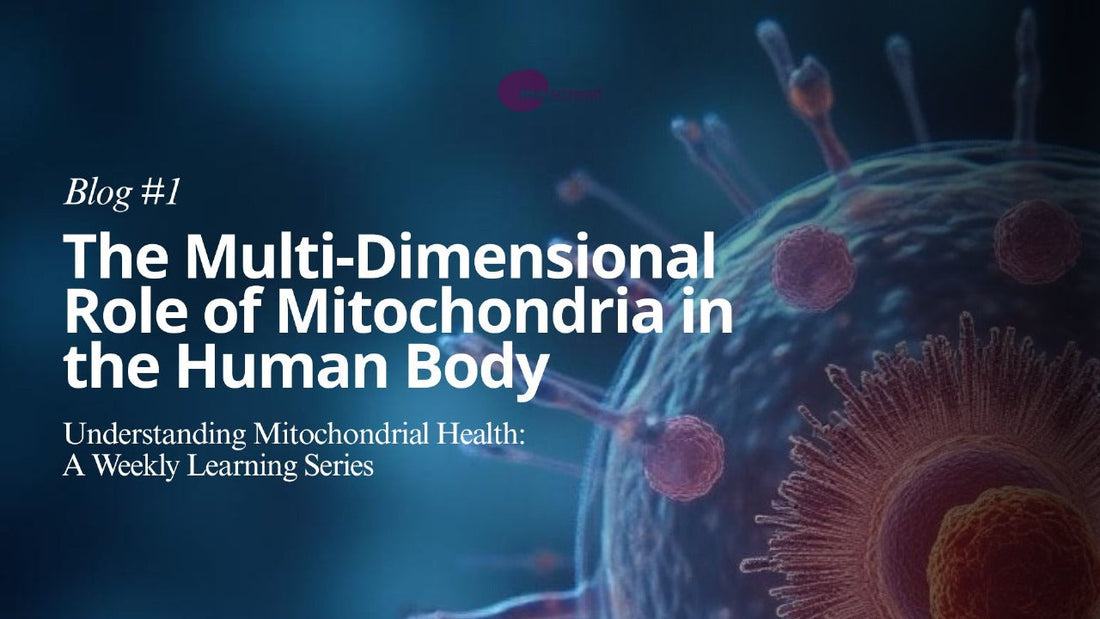Understanding Mitochondrial Health: A Weekly Learning Series
The Multi-Dimensional Role of Mitochondria in the Human Body
We’ve all heard that mitochondria are the “powerhouses” of the cell, and that’s true. But that nickname barely scratches the surface. These tiny, bean-shaped structures are like the cell’s multitaskers, handling way more than just energy production. They help run your metabolism, keep cells alive (or help them die when they should), support your brain and muscles, and even play a role in how we age.
When mitochondria are working well, your body runs smoothly. But when they start to struggle, the effects can be felt almost anywhere, from your heart to your brain to your muscles.
What Do Mitochondria Actually Do?
- 🔋 They make energy – Mitochondria turn food into ATP, the fuel your cells need.
- ☠️ They help decide when a cell should die – Clearing out damaged cells keeps your body healthy.
- ⚡ They manage calcium levels – Controlling calcium for muscles, nerves, and hormones.
- 🧪 They create reactive oxygen species (ROS) – Helpful in small amounts, damaging in excess.
- 🔄 They run metabolism – Breaking down fats/proteins and detoxifying waste.
Each week, we’ll break down one of these layers to enhance your understanding of mitochondria.
How Mitochondria Are Built to Do Their Job
| Part | What It Does |
|---|---|
| Outer membrane | Acts like a security gate — lets small molecules in/out. |
| Inner membrane | Holds the machinery needed to make energy. |
| Cristae | Folds that create more space for energy-making. |
| Matrix | Holds mitochondrial DNA and enzymes for metabolism. |
| Intermembrane space | Helps build pressure that drives ATP production. |

Making Energy: The Cell’s Power Plant
One of the most important things mitochondria do is turn the food you eat into ATP, the cell’s battery pack.
🌀 What’s the Krebs Cycle?
The Krebs cycle extracts high-energy electrons from food molecules and prepares them for ATP production, releasing carbon dioxide as waste.
⚙️ What’s the Electron Transport Chain?
The ETC uses those electrons to pump protons, creating pressure that drives ATP synthase — the main ATP generator. If this breaks down, energy production fails.
Cell Death (Apoptosis) = Cell Renewal
Mitochondria help remove old or faulty cells via apoptosis. Without it, damaged cells could accumulate and lead to cancer or autoimmune disease.
Calcium Control: Keeping Cell Signals in Balance
- 💪 Muscles contract
- 🧠 Nerves send messages
- 💬 Hormones get released
Balanced calcium levels ensure energy production, communication, and survival. Mitochondria act as regulators of this process.
Creation of Free Radicals: Helpful and Harmful
Mitochondria produce ROS during energy-making. In small amounts they’re useful messengers, but too much can damage DNA, proteins, and membranes.
Running Metabolism: The Cell’s Control Center
Mitochondria break down fats and proteins, process waste, and adjust energy based on demand, making them key metabolic managers.
Mitochondrial DNA and Inherited Disease
Mitochondria have their own DNA, inherited only from mothers. Mutations can cause diseases affecting high-energy organs like the brain, muscles, and heart.
| Disease | Main Symptoms | Inheritance |
|---|---|---|
| MELAS | Muscle weakness, seizures, stroke-like events | Mother |
| MERRF | Epilepsy, coordination problems | Mother |
| KSS | Muscle weakness, heart rhythm, vision loss | Mother |
| LHON | Sudden vision loss | Mother |

Conclusion: Why Mitochondria Matter So Much
Mitochondria are more than power plants — they regulate energy, metabolism, aging, and disease protection. Tools like mescreen™ may soon make mitochondrial health easier to track, helping us personalize healthcare and improve longevity.

